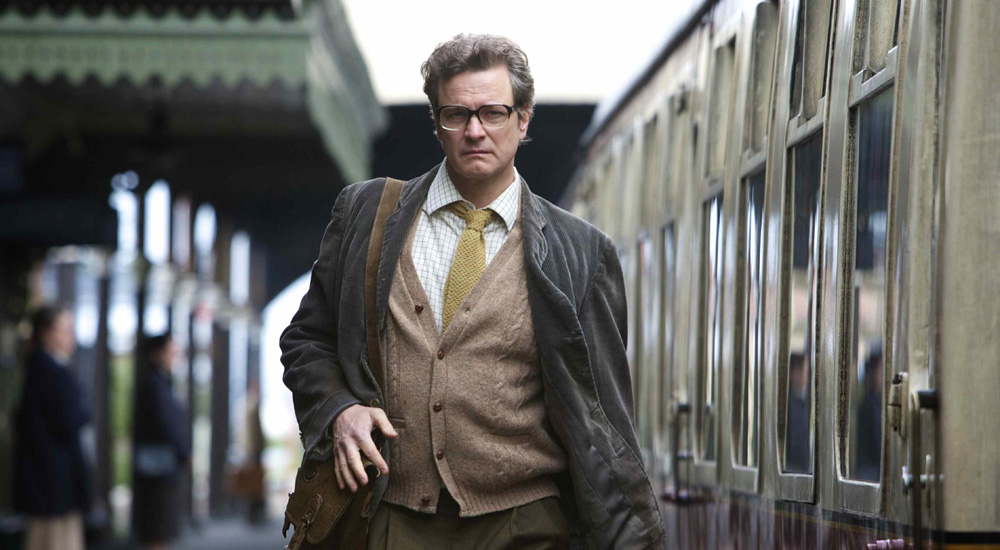There are some remarkably complex compositions in Jonathan Teplitzky’s adaptation of Eric Lomax’s autobiography “The Railway Man,” not least of which is the one that makes up the man at its center. While he lived to tell of his experience as an engineer in the British Army during World War II, Lomax continued to be haunted by his years spent in a Japanese prison camp where he and other POWs were forced to pave the way for the Imperial Army to bolster their military stronghold in Burma with the construction of a railway connecting it to Thailand.
For Teplitzky, who so vividly realized the past’s influence on the present in his last film “Burning Man,” which saw Matthew Goode deal with the personal demons of a man who recently lost his wife, “The Railway Man” is an opportunity to explore that theme on a grander scale when Lomax (played by Colin Firth primarily in his older years and Jeremy Irvine in his youth abroad) meets the woman he was meant to marry (Nicole Kidman) and yet cannot fully share his life with her since the horrors that he’s seen shouldn’t be shared with anyone. With an inimitable editing style and a time-shifting script from “Millions” writer Frank Cottrell Boyce, the filmmaker places the audience in Lomax’s head as he tries to reconcile his torturous time in Burma with what promises to be a brighter future if only he can put his past behind him.
Shortly before the film’s release, Teplitzky spoke about how a lucky break led to “The Railway Man,” how his focus on character over plot has served him well and the impact of having the real Lomax on set shortly before he passed in October 2012.

Some friends of mine were actually developing it for a number of years and one of my best friends was actually the original director on it, so I knew of the project without knowing that much about it. For all sorts of reasons, he couldn’t do it and one of the producers, who also produced “Burning Man” with me, came to me and asked if I’d be interested. When I read the story in great detail, it just struck me as such an amazing story that as a filmmaker, you’re extremely lucky to have such a story fall in your lap like that.
Was it a different experience coming into a project that way as opposed to originating it yourself?
A little bit, because when you write something, you know the film back to front. But there’s something really good about coming to the material so fresh that you dive into the research and the story and into the people that it’s very invigorating. The story of Eric Lomax encapsulated all the very best and the very worst of what human beings are capable of and it was very easy to get engaged with something like that.
This film and your last, “Burning Man,” share a kinetic editing style that’s particularly effective in thrusting an audience into the fractured memory of the films’ characters. Has that been a style that’s evolved over time or has it just come naturally?
It’s a little bit instinctive. I try to tell stories from an emotionally truthful place. I’m much more interested in the emotional landscape than I am in the naturalistic one and the tone and the rhythm and the pace and all these things come together [in the edit]. When you’re focusing on the emotional, you edit a film in different ways, you write a film in different ways and you construct scenes in different ways. That’s why character intrigues me more than purely linear plot because [when you focus on the latter] it feels too disconnected often from the visceral emotional journey that a character takes.

You take a leap of faith with these things and it always helps to have great actors. The work Colin [Firth] and Jeremy [Irvine] did together to create that singularity of character for Eric Lomax is in many ways what makes the film work so well. What we talked about a lot is that we just never wanted to be taken out of the movie when you suddenly went back or forward in time to the other actor playing the character. We wanted to always feel you were connected to this story of this singular character. The material really helps you because there’s a certain psychological and emotional tension that is carried through the film, just simply because it’s uncovering the darkness within the soul of the character as we slowly reveal the machinations at play that caused him to be the person that he was and to survive what he did.
Both in this film and “Burning Man,” you deal with grief in a way that few filmmakers do – of how selfish does one need to be in order to protect themselves from further hurt versus how they’ll find freedom in sharing their pain with others. Is that something that remains compelling for you or is it simply a coincidence that these two films have dealt with it?
It is compelling to me. I had a partner of many years who passed away from breast cancer 12 years ago, which was the starting point of “Burning Man” and it is a very selfish thing, but also it’s a many-faceted thing. The thing with “Burning Man” was that juxtaposition of the tragedy and the sadness and the grief, but with an energy of almost exhilaration because change is in and of itself exciting. When you’re in that churned up emotional state, it’s not just about how devastated you feel, but also how you search almost viscerally to achieve some kind of pain remedy.
With “Railway Man,” it’s a slightly different thing, but I think it’s a really good observation that there is a selfishness in grief, yet we have no choice in the matter. I go back to that idea of trying to tell an emotional truth about the characters. If you sugarcoat that [process of grieving], it undermines that, particularly with “Railway Man” where it was about real people’s lives. I was very conscious of wanting to do justice and honor what Eric Lomax and his wife went through as best I could.

We filmed in his hometown for a few days and he and his wife came on set for a little bit. When we were in Thailand, a lot of those scenes were filmed on what’s left of the Thai-Burma Railway and when you’re dealing with a real story like this, just being in the real places particularly when so much pain and suffering has occurred in them, you can palpably feel an atmosphere that in some ways reflects what went on there. It’s just a very strange atmosphere to describe, but it lends a great ear and air of authenticity — those scenes of the building of the railway is actually on the railway — so again it brings a visceral quality to the film that I think it wouldn’t otherwise have had.
I haven’t been able to shake the opening shot with the bridge in the background, an intricate structure with this obviously fragile man standing before it, and wondered throughout whether there was consciousness about how you positioned characters in the film within their physical surroundings.
It was a relatively conscious thing. That opening shot, I wanted to do a lot of things there. I wanted to put old and new together, so you open with Jeremy [Irvine as the younger Eric Lomax] coming across that shot of the bridge and then the poem that the older Eric recites starts playing over that and what I was trying to do was set up this whole idea of this haunted character. There’s something incredibly moving about that bridge in the mist and it’s such an incredible structure it almost looks stuck on and to see this young boy really in a soldier’s uniform limping in front, it immediately conjures so many things that the film is about. Then when Colin [Firth’s Eric Lomax] is lying on the floor, reciting that poem, it tells [of] the psychological world that the film is going to certainly deal with as the film progresses.

I guess the gap was for all sorts of reasons. My first film was “Better Than Sex,” then I made a crime comedy in Australia called “Getting Square,” which was about six, seven years ago. I took a couple of years to recover from all sorts of things, from my partner dying and I did a lot of writing in that time and a lot of traveling and I had a young son. But I certainly wanted to respond to all that in a creative way and I think I just found another dimension about what I wanted to do in my films and with the characters. That resulted in “Burning Man” and the complexity and substance of “Railway Man” was a very succinct and neat thing to follow it with because it just tapped into these big themes of reconciliation and forgiveness, but also the intimacy of characters trying to cope with those issues. I like that a film can have incredible scale, but it never ceases to be an intimate drama as well because it’s the people who populate those things, the way we connect and engage with those individual characters that really bring these stories alive.
“The Railway Man” opens in Los Angeles and New York on April 11th and expands into limited release on April 18th.




